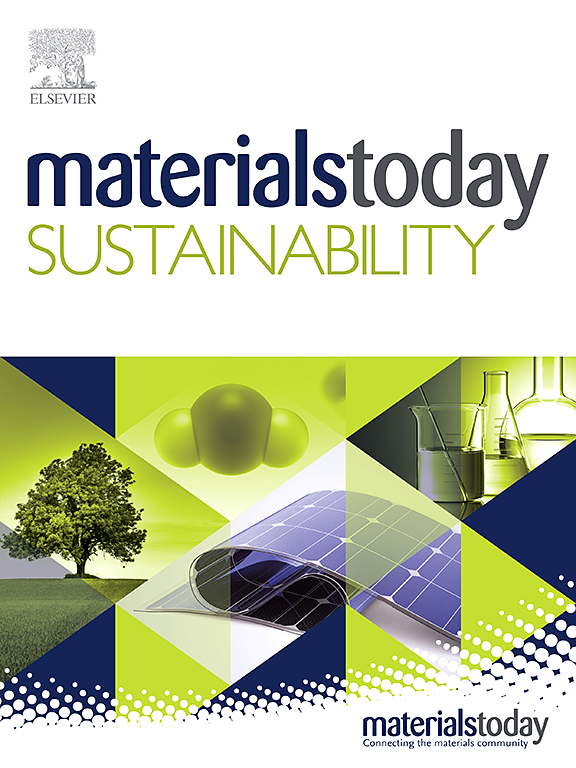固体废弃物固化材料固化土壤的碳排放、耐久性及应用
IF 7.9
3区 材料科学
Q1 GREEN & SUSTAINABLE SCIENCE & TECHNOLOGY
引用次数: 0
摘要
本文对不同性能梯度固体废物基固化材料的碳排放和经济效益进行了比较分析。系统研究SSM的宏观特性,旨在深入了解SSM对冻融循环、海水侵蚀、干湿循环和干收缩等条件的响应。为了便于本研究,采用了一系列的分析技术,包括扫描电子显微镜(SEM), x射线衍射(XRD)和汞侵入孔隙度测定(MIP)。结果表明,与水泥相比,SSM (A1)的碳排放量减少了77.7%,为190 kg/t,碳性能比(24.4 kg/MPa)、成本效益比(32.1RMB/MPa)和碳成本比(0.76kg/RMB)分别降低了86%、56%和68%。SSM在抗冻融性能、耐海水侵蚀性能和干湿性能方面均优于水泥。与水泥固化土相比,SSM固化土的干收缩值在40天内减少了约35%,这是由于补偿性收缩和孔隙的减少。与海水侵蚀相对较小的影响和干湿循环的中等影响相比,冻融循环对固化土微观结构的破坏最为严重。耐久性测试的传导导致孔隙率和最可能的孔径增加。孔隙和微观结构的增加导致SSM固化土宏观力学性能的衰减。工程应用验证,当SSM掺量为50 kg/m、4.5%和3%时,SSM改性土在深层搅拌桩、浅层原位固化和路基改性土现场的强度、承载力和弯曲值分别为1.9 MPa、180 kPa和158。本文章由计算机程序翻译,如有差异,请以英文原文为准。
Carbon emission, durability and application of solid waste based solidification material solidification soil
The present paper sets out a comparative analysis of carbon emission and economic benefit of different performance gradients solid waste based solidification material (SSM). The macro properties of SSM were the focus of systematic study, with the aim of gaining deeper insight into the response of the SSM to conditions such as freeze-thaw cycles, seawater erosion, dry-wet cycles and dry shrinkage. In order to facilitate this study, a range of analytical techniques were employed, including scanning electron microscopy (SEM), X-ray diffraction (XRD) and mercury intrusion porosimetry (MIP). The findings indicate that, in comparison with cement, the carbon emissions of SSM (A1) are diminished by 77.7 %, amounting to 190 kg/t, the carbon-performance ratio (24.4 kg/MPa), the cost-performance ratio (32.1RMB/MPa) and the carbon-cost ratio (0.76kg/RMB) are reduced by 86 %, 56 % and 68 % respectively. SSM demonstrated better performance in terms of freeze-thaw resistance, seawater erosion resistance and dry-wet resistance when compared to cement. The dry shrinkage value of SSM solidified soil was reduced by approximately 35 % at 40 days compared to cement solidified soil, due to compensatory shrinkage and a reduction in pores. In contrast to the relatively minor impact of seawater erosion and the moderate effects of the wet-dry cycle, freeze-thaw cycles have been shown to cause the most severe structural damage to the micro-structure of solidified soil. The conduction of durability tests resulted in increased porosity and the most probable aperture. The increase in pores and micro-structure leads to the attenuation of macroscopic mechanical properties of SSM solidified soil. The engineering application verified that with the content of SSM of 50 kg/m, 4.5 % and 3 %, the strength, bearing capacity and bending value of SSM modified soil were 1.9 MPa, 180 kPa and 158, respectively in deep mixing piles, shallow in-situ solidification, and roadbed modified soil field.
求助全文
通过发布文献求助,成功后即可免费获取论文全文。
去求助
来源期刊

Materials Today Sustainability
Multiple-
CiteScore
5.80
自引率
6.40%
发文量
174
审稿时长
32 days
期刊介绍:
Materials Today Sustainability is a multi-disciplinary journal covering all aspects of sustainability through materials science.
With a rapidly increasing population with growing demands, materials science has emerged as a critical discipline toward protecting of the environment and ensuring the long term survival of future generations.
 求助内容:
求助内容: 应助结果提醒方式:
应助结果提醒方式:


